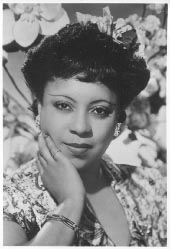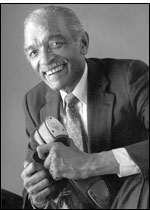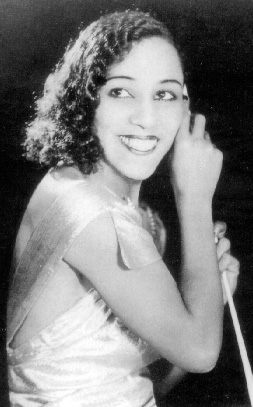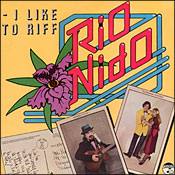Related Research Articles
"Stormy Weather" is a 1933 torch song written by Harold Arlen and Ted Koehler. Ethel Waters first sang it at The Cotton Club night club in Harlem in 1933 and recorded it with the Dorsey Brothers' Orchestra under Brunswick Records that year, and in the same year it was sung in London by Elisabeth Welch and recorded by Frances Langford. Also in 1933, for the first time the entire floor revue from Harlem's Cotton Club went on tour, playing theatres in principal cities. The revue was originally called The Cotton Club Parade of 1933 but for the road tour it was changed to Stormy Weather Revue; it contained the song "Stormy Weather", which was sung by Adelaide Hall.

Cabell Calloway III was an American jazz singer and bandleader. He was a regular performer at the Cotton Club in Harlem, where he became a popular vocalist of the swing era. His niche of mixing jazz and vaudeville won him acclaim during a career that spanned over 65 years.

James Melvin Lunceford was an American jazz alto saxophonist and bandleader in the swing era.

The Cotton Club was a New York City nightclub from 1923 to 1940. It was located on 142nd Street and Lenox Avenue (1923–1936), then briefly in the midtown Theater District (1936–1940). The club operated during the United States' era of Prohibition and Jim Crow era racial segregation. Black people initially could not patronize the Cotton Club, but the venue featured many of the most popular black entertainers of the era, including musicians Fletcher Henderson, Duke Ellington, Jimmie Lunceford, Chick Webb, Louis Armstrong, Count Basie, Fats Waller, Willie Bryant; vocalists Adelaide Hall, Ethel Waters, Cab Calloway, Bessie Smith, Lillie Delk Christian, Aida Ward, Avon Long, the Dandridge Sisters, the Will Vodery choir, The Mills Brothers, Nina Mae McKinney, Billie Holiday, Midge Williams, Lena Horne, and dancers such as Katherine Dunham, Bill Robinson, The Nicholas Brothers, Charles 'Honi' Coles, Leonard Reed, Stepin Fetchit, the Berry Brothers, The Four Step Brothers, Jeni Le Gon and Earl Snakehips Tucker.
Whitey's Lindy Hoppers was a professional performing group of exceptional swing dancers that was first organized in the late 1920s by Herbert "Whitey" White in the Savoy Ballroom and disbanded in 1942 after its male members were drafted into World War II. The group took on many different forms and had several different names and sub-groups, including Whitey's Hopping Maniacs, Harlem Congeroo Dancers, and The Hot Chocolates. In addition to touring nationally and internationally, the group appeared in several films and Broadway theatre productions. Dorothy Dandridge and Sammy Davis Jr. were among the group's celebrity regulars.

Charles "Cholly" Atkins was an American dancer and vaudeville performer, who later became noted as the house choreographer for the various artists on the label Motown.

Adelaide Louise Hall was an American-born UK-based jazz singer and entertainer. Her career spanned more than 70 years from 1921 until her death. Early in her career, she was a major figure in the Harlem Renaissance; she became based in the UK after 1938. Hall entered the Guinness Book of World Records in 2003 as the world's most enduring recording artist, having released material over eight consecutive decades. She performed with major artists such as Art Tatum, Ethel Waters, Josephine Baker, Louis Armstrong, Lena Horne, Bill "Bojangles" Robinson, Cab Calloway, Fela Sowande, Rudy Vallee, and Jools Holland, and recorded as a jazz singer with Duke Ellington and with Fats Waller.

Charles "Honi" Coles was an American actor and tap dancer, who was inducted posthumously into the American Tap Dance Hall of Fame in 2003. He had a distinctive personal style that required technical precision, high-speed tapping, and a close-to-the-floor style where "the legs and feet did the work". Coles was also half of the professional tap dancing duo Coles and Atkins, whose specialty was performing with elegant style through various tap steps such as "swing dance", "over the top", "bebop", "buck and wing", and "slow drag".

Blanche Dorothea Jones Calloway was an American jazz singer, composer, and bandleader. She was the older sister of Cab Calloway and was a successful singer before her brother. With a music career that spanned over fifty years, Calloway was the first woman to lead an all-male orchestra and performed alongside musicians such as Cozy Cole, Chick Webb, and her brother. Her performing style was described as flamboyant and a major influence on her brother's performance style.

"Nobody's Sweetheart", also known as "Nobody's Sweetheart Now" and "You're Nobody's Sweetheart Now", is a popular song, written in 1924, with music by Billy Meyers and Elmer Schoebel, and lyrics by Gus Kahn and Ernie Erdman. The song is a jazz and pop standard.

I Like to Riff was the first recording by the Minneapolis jazz vocal trio Rio Nido, released in 1978. The original LP was long out-of-print until re-released on CD in 2007 by the Japanese label, Bittersweet America.
Howard Eugene "Stretch" Johnson was an American tap dancer and social activist.
The Cab Calloway Orchestra, based at the exclusive Cotton Club in Harlem, was, for more than a decade, one of the most important jazz bands in America. Different lineups featured the best available established musicians.

Leonard Harper was a producer, stager, and choreographer in New York City during the Harlem Renaissance in the 1920s and 1930s.
The Paradise Club or Club Paradise was a nightclub and jazz club at 220 North Illinois Avenue in Atlantic City, New Jersey. It was one of two major black jazz clubs in Atlantic City during its heyday from the 1920s through 1950s, the other being Club Harlem. Entertaining a predominantly white clientele, it was known for its raucous floor shows featuring gyrating black dancers accompanied by high-energy jazz bands led by the likes of Count Basie, Jimmie Lunceford, and Lucky Millinder. In 1954 the Paradise Club merged with Club Harlem under joint ownership.
Ollie Potter was an American female blues singer, notably of Cleveland and New York City, and a dancer, particularly of the shimmy style.
A class act is a performance or personal trait or behavior that is distinctive and of high quality. As a noun phrase, it is typically used to refer to a single person, a team – such as a performing artists working together – or an organization.
Cyril Nathaniel "Spider" Haynes was an American jazz pianist and arranger.

Miller Brothers and Lois, a renowned tap dance class act team, comprising Danny Miller, George Miller and Lois Bright, was a peak of platform dancing with the tall and graceful Lois said to distinguish the trio. The group performed the majority of their act on platforms of various heights, with the initial platform spelling out M-I-L-L-E-R. They performed over-the-tops, barrel turns and wings on six-foot-high pedestals. They toured theatres coast to coast with Jimmy Lunceford and his Orchestra, Cab Calloway and his Orchestra, and the Count Basie Band.
Gary "Pete" Nugent was an American tap dancer known as "Public Tapper, Number 1". He was also part of the class act, Pete, Peaches, and Duke.
References
- ↑ "Cotton Club Boys Pioneered in Precision Chorus Dancing", Ebony , Vol. 9, No. 8, June 1954, pg. 118; ISSN 0012-9011 (accessible via EBSCO Information Services – Accession No. 48949393 [ dead link ]; subscription required)
- ↑ On and Off the Bandstand: A Collection of Essays Related to the Great Bands ..., by Author Bradley, iUniverse (2005); OCLC 633537244
- ↑ "Cotton Club Figure Dies" (Walter Brooks; 1884–1968) The New York Times , November 23, 1968, pg. 2
- ↑ "Cotton Club" (alt link), Cary D. Wintz & Paul Finkelman (eds.), Encyclopedia of the Harlem Renaissance (Vol. 1 of 2; A–J), Routledge (2004), pg. 256; OCLC 648136726, 56912455
- ↑ "Club Venues" (encyclopedic entry), Music in American Life: An Encyclopedia of the Songs, Styles, Stars, and Stories That Shaped Our Future (Vol. 1; A–C), Jacqueline Edmondson, Ph.D. (ed.), Greenwood Press (2013); OCLC 911398950
- ↑ "Kirk Little Affected by Fair Competition," Pittsburgh Courier , June 1, 1940, pg. 21
- ↑ "Broadway's Cotton Club Closes – May Reopen With New Kirk Show in July," Pittsburgh Courier , June 22, 1940, pg. 21
- ↑ To Be, Or Not ... To Bop, by Dizzy Gillespie, University of Minnesota Press (1st pub. 1979; 2009), pg. 108; OCLC 442778381
- 1 2 3 4 5 "Cotton Club Boys (biography)," Performing Arts Encyclopedia c/o Library of Congress (online) (retrieved February 21, 2017)Cotton Club Parade productions:
(browse Encyclopedia) - ↑ "Cotton Club Boys (biography)," Performing Arts Encyclopedia (continued)Music and literature:
(browse Encyclopedia) - 1 2 Vaudeville Old & New – An Encyclopedia of Variety Performers in America (Vol. 1), Frank Cullen, Routledge (2004); OCLC 53155485
- ↑ "New Cotton Club Revue Premieres 'Mid Celebs – Show, Produced By Ted Koehler, Stars Nina Mae, Torch Singer," by A. McM, New York Age , July 27, 1935, pg. 4
- ↑ "Clarence Robinson Presents Greatest Colored Show To Gay Broadway via Famed Cotton Club," by William L. "Billy" Rowe (1913–1997), Pittsburgh Courier , October 3, 1936
- ↑ "Cotton Club Boys (biography)," Performing Arts Encyclopedia (continued) Original source: The Cotton Club by James Edward Haskins (1941–2005)
- ↑ A Century of Musicals in Black and White: An Encyclopedia of Musical Stage Works By, About, or Involving African Americans, by Bernard L. Peterson, Greenwood Press (1993), pps. 46–47; OCLC 770995297
- ↑ "The Play – Out of Tune" (performance review), by B.C. (Bosley Crowther), The New York Times , December 21, 1936
- ↑ "Cotton Club presents Cotton Club Parade" (program; 5th ed.) (1938); OCLC 951748496
- ↑ "The New Play – 'The Hot Mikado,' Non-WPA Version, Opens at the Broadhurst Theater," by Richard Lockridge, New York Sun , March 24, 1939, pg. 22
- ↑ Glenn and Jenkins Scrapbook, 1922–1962, New York Public Library for the Performing Arts; OCLC 122686765
- ↑ An Encyclopedia of South Carolina Jazz and Blues Musicians Benjamin V. Franklin V, PhD (born 1939), University of South Carolina Press (2016); OCLC 927379753
"Jenkins, Walter (Walter Manigault)" (pg. 366)
"Glenn, William Henry" (pg. 259) - ↑ "News of Night Clubs", by Theodore Strauss (né Theodore William Strauss; 1912–1989), The New York Times , March 19, 1939
- ↑ "Broadway Applauds Star-Studded Cast," by Isadora Smith, Pittsburgh Courier , April 2, 1939, pg. 20
- 1 2 "Cotton Club Boys' Smooth Act A Hit," Pittsburgh Courier , June 1, 1940, pg. pg. 20 (with photo) (accessed via www
.newspapers .com ) - ↑ "Cab Calloway's New Revue Set For The Apollo Theatre," New York Age , November 22, 1940, pg. 4
- ↑ Swingin' on the Ether Waves: a Chronological History of African Americans in Radio and Television Broadcasting, 1925–1955, by Henry T. Sampson, Scarecrow Press (2005); OCLC 53846580
- ↑ "Winifred (Winnie) Johnson, Sang With Duke Ellington's Orchestra", The New York Times , October 30, 1980
- ↑ A Dancer in the Revolution: Stretch Johnson, Harlem Communist at the Cotton Club, Howard Eugene Johnson, Fordham University Press (2014), pg. 33; OCLC 907437335
- ↑ "Veteran Troupe Celebrates 'This Is the Army'" by Kathryn Shattuck, The New York Times , June 9, 1997
- ↑ "Let the Punishment Fit the Crime: The Vocal Choreography of Cholly Atkins," by Jacqui Malone, Dance Research Journal , Vol. 20, No. 1, Summer 1988, pps. 11–18 (retrieved March 17, 2917, via JSTOR)
- ↑ Class Act: The Jazz Life of Choreographer Cholly Atkins, by Cholly Atkins & Jacqui Malone, Columbia University Press (2001), pg. 43; OCLC 974087440